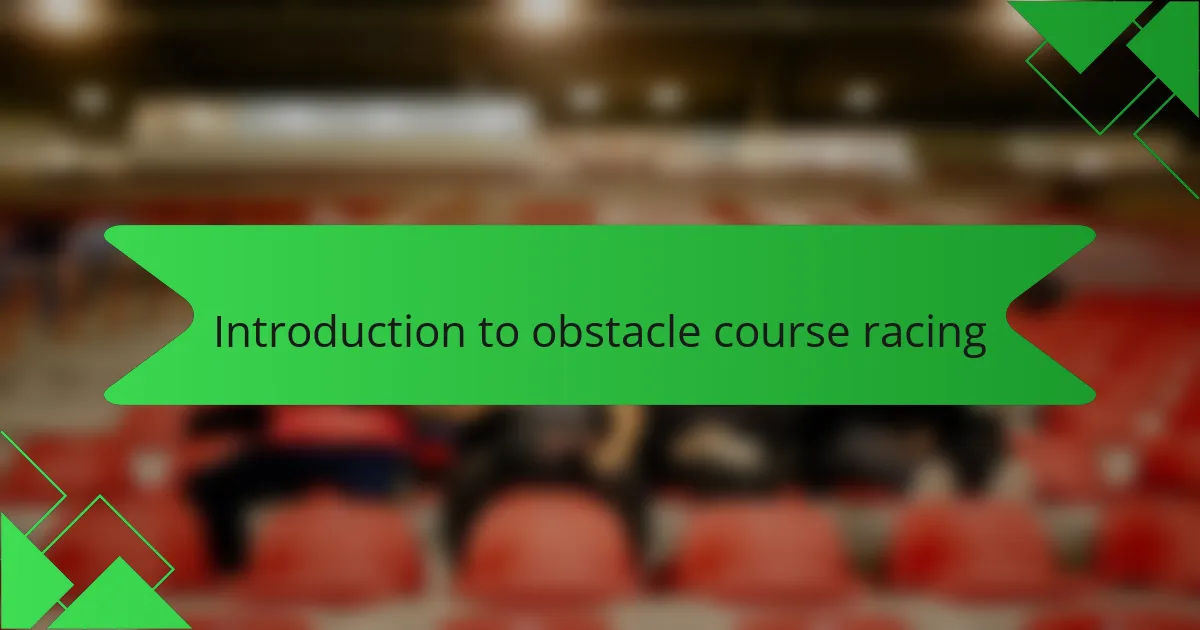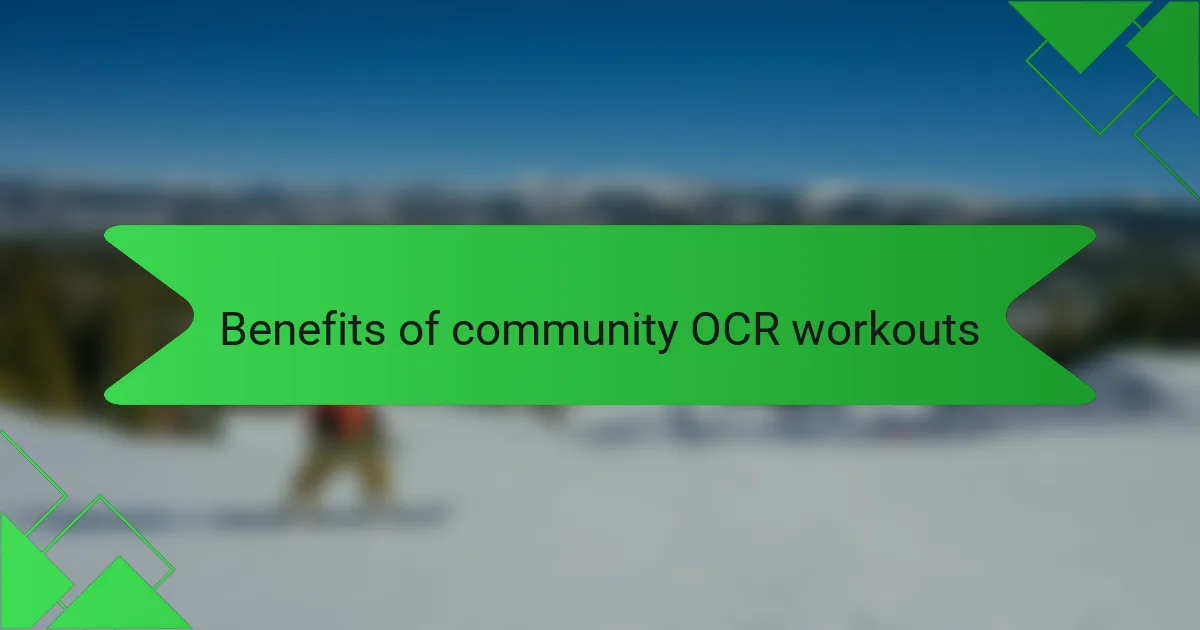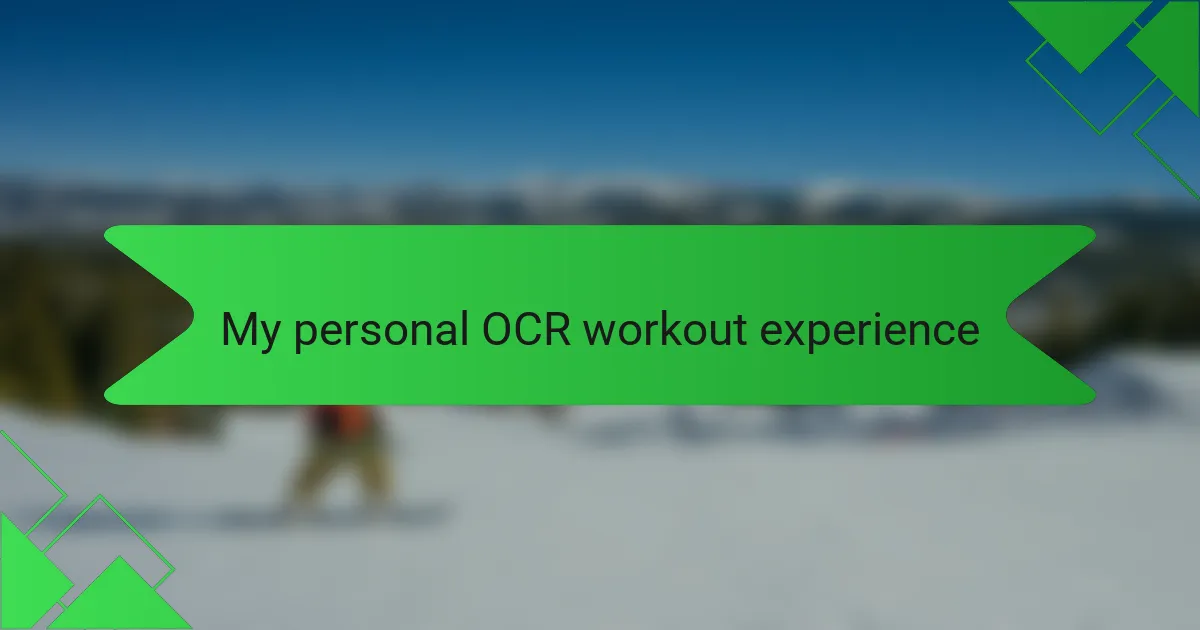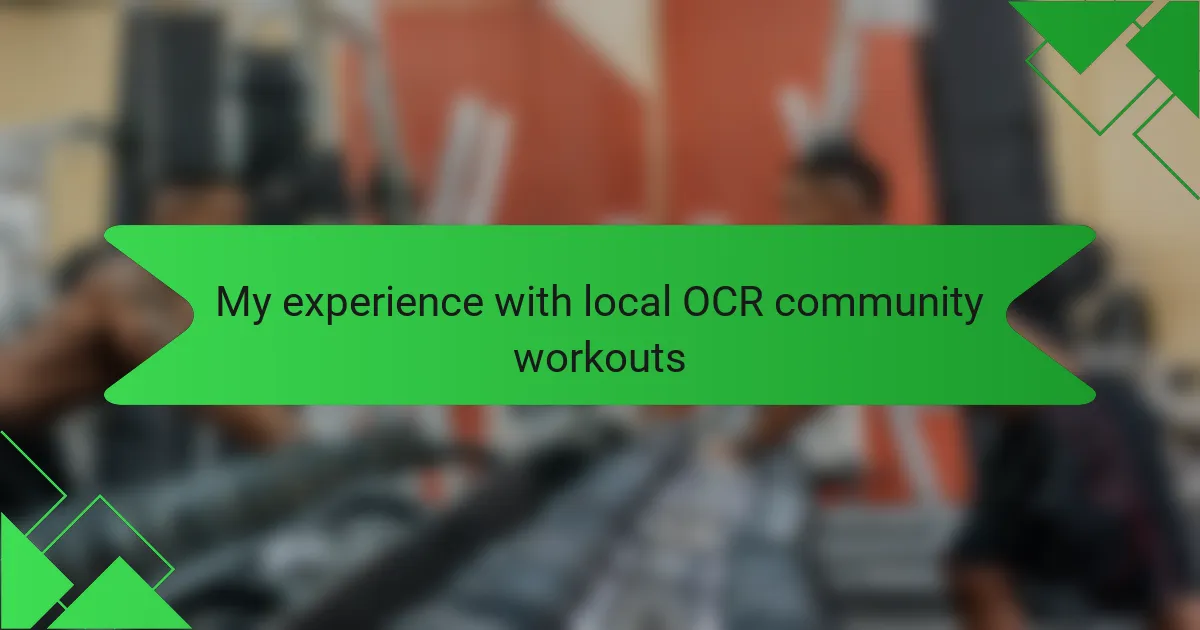Key takeaways
- Obstacle course racing combines endurance, strength, and technique, fostering camaraderie in community workouts.
- Participating in local OCR groups enhances motivation, accountability, and skill development through shared experiences.
- Proper preparation, including the right gear and a positive mindset, significantly improves the workout experience.
- New participants should focus on foundational skills and pacing to build confidence and stamina over time.

Introduction to obstacle course racing
Obstacle course racing (OCR) is a thrilling sport that combines running with physical challenges like climbing, crawling, and jumping. When I first tried OCR, I was hooked by the mix of endurance and strength—it’s unlike any other workout I’d done. The camaraderie in local workouts made the experience even more rewarding.
These local OCR community workouts provide a great way to build skills in a fun, supportive environment. They remind me why OCR is not just about personal fitness but also about pushing limits alongside others who share the same passion.
| Traditional Running | Obstacle Course Racing (OCR) |
|---|---|
| Focuses mainly on cardiovascular endurance | Combines endurance with strength, agility, and technique |
| Usually done on flat or paved surfaces | Involves varied terrain and obstacles like mud, walls, and ropes |
| Solo activity | Often a social activity with a strong community aspect |
| Predictable and repetitive | Always different and challenging due to varied obstacles |

Benefits of community OCR workouts
One thing I’ve noticed is how community OCR workouts create a unique sense of belonging. When you’re struggling to conquer a tricky wall or gasp for breath after a tough run, having a group around who truly get it makes all the difference. Don’t you think it’s easier to push harder when people are cheering you on and sharing the same struggle?
Beyond motivation, these workouts offer incredible opportunities to learn new techniques. I remember the first time someone showed me a better way to tackle a rope climb—it completely changed how effective I was during races. Being part of a community means you get tips and encouragement that you just can’t find on your own.
Finally, the accountability factor can’t be underestimated. It’s one thing to say you’ll train alone, but when you know a group is waiting for you, you’re more likely to show up. I’ve definitely experienced those days when getting out of bed felt impossible, yet knowing friends were counting on me gave me the extra push to lace up and get moving.

Finding local OCR groups
Finding local OCR groups was surprisingly easier than I initially thought. I started by searching social media platforms and local fitness forums, and pretty quickly, I stumbled upon a few clubs that regularly host community workouts. Have you ever been pleasantly surprised by how welcoming a group can be when you show up for the first time? That was definitely my experience.
What struck me the most was how these groups often advertise through word of mouth and casual meetups at parks or training facilities. One time, I just tagged along to a Saturday session after a friend mentioned it, and before I knew it, I was part of the crew. It’s amazing how networking in the OCR community can open doors you didn’t even know existed.
Another useful tip I discovered is to check local obstacle course events or gyms that specialize in functional training—they often have flyers or bulletin boards with info about nearby OCR groups. When I took that extra step to visit these spots, it really paid off by connecting me with seasoned racers eager to share their knowledge. Do you think taking initiative like that could help you find your ideal training group? I’m convinced it will.

Preparing for group workouts
Preparing for group workouts takes a bit more planning than solo training, especially with obstacle course racing where teamwork and camaraderie add a unique layer of motivation. From my own experience, showing up prepared not only helped me keep pace but also boosted my confidence within the group dynamic.
One thing I’ve learned is that having the right gear and mindset sets the tone for the entire session. I remember a time when I forgot my gloves and ended up struggling with grip-intensive obstacles, which made me appreciate how small details can impact performance and morale.
Here’s what I usually focus on before joining local OCR community workouts:
- Wear moisture-wicking clothes that are durable for crawling and climbing
- Bring a water bottle to stay hydrated throughout the session
- Pack gloves or tape for better grip and skin protection
- Warm up with dynamic stretches tailored for obstacle movements
- Arrive with a positive attitude ready to encourage and be encouraged
- Check the workout’s duration and intensity to adjust nutrition accordingly
- Review any specific workout plans or obstacles if shared beforehand
Preparing this way made my group workouts more effective and enjoyable, turning challenges into shared victories.

What to expect during workouts
What to expect during workouts
When I first joined local OCR community workouts, I wasn’t sure what to expect, but I quickly realized these sessions are a mix of intense training, skill-building, and lots of encouragement. The workouts push your limits but never leave you feeling discouraged; there’s a real sense of camaraderie that made me look forward to every session. The variety keeps things exciting—one day might be focused on endurance, while another hones your grip strength or obstacle technique.
| Aspect | Local OCR Community Workouts |
|---|---|
| Training Focus | Combination of endurance, strength, and obstacle technique work |
| Atmosphere | Supportive and motivating community environment |
| Workout Intensity | Challenging but adaptable to all fitness levels |
| Variation | Regularly changing drills and exercises to target different OCR skills |
| Equipment | Minimal; mostly bodyweight, ropes, tires, and course-like obstacles |

My personal OCR workout experience
My workouts with the local OCR community have been a game-changer for me. The energy and encouragement from everyone pushed me beyond my usual limits, making tough obstacles feel conquerable. I remember the first time I barely made it over a wall—it was exhilarating and made me realize how much group support mattered.
| Solo Workouts | Local OCR Community Workouts |
|---|---|
| Motivation can lag; easy to skip sessions. | Higher motivation due to group energy and accountability. |
| Limited access to varied obstacles. | Access to diverse obstacles tailored to OCR training. |
| Less feedback on technique. | Immediate tips and encouragement from experienced members. |
| Can feel isolating. | Social bonding and shared excitement. |

Tips for new OCR participants
Starting out in OCR can feel overwhelming, right? From my experience, my best tip is to focus on learning the basics first—mastering fundamental movements like crawling, climbing, and balancing. I remember how breaking down each obstacle into smaller steps made me feel more confident and less intimidated during workouts.
Another thing I’ve found helpful is pacing yourself. It’s tempting to push hard at the start, but OCR is really about endurance and technique working together. When I tried to sprint through my first session, I burned out quickly and struggled to finish. Slowing down and maintaining a steady rhythm helped me keep going and enjoy the challenge.
Lastly, don’t forget to ask questions and seek advice from those around you. The OCR community is full of people willing to share tips and cheer you on. I still recall a moment when a fellow member showed me a grip trick for monkey bars—that small tip made a huge difference in my upper-body strength and confidence. Have you experienced that kind of unexpected help that turns a tough spot into a breakthrough? It’s what makes community workouts so valuable.
